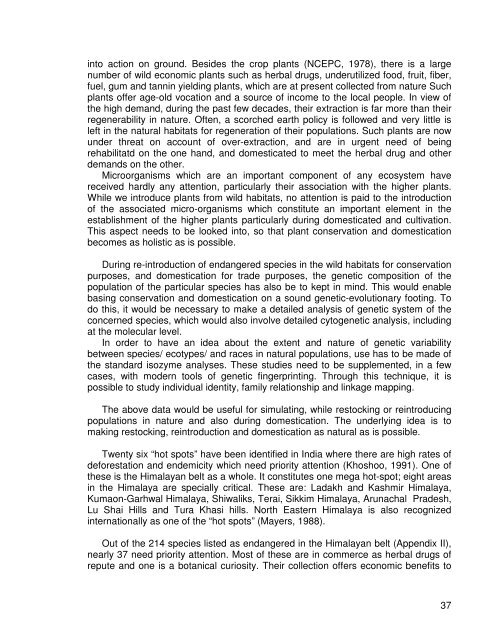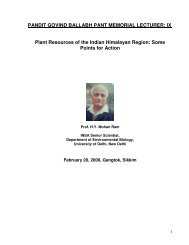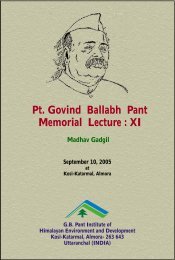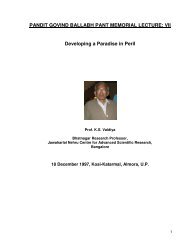Pandit Govind Ballabh Pant Memorial Lecture: II
Pandit Govind Ballabh Pant Memorial Lecture: II
Pandit Govind Ballabh Pant Memorial Lecture: II
You also want an ePaper? Increase the reach of your titles
YUMPU automatically turns print PDFs into web optimized ePapers that Google loves.
into action on ground. Besides the crop plants (NCEPC, 1978), there is a large<br />
number of wild economic plants such as herbal drugs, underutilized food, fruit, fiber,<br />
fuel, gum and tannin yielding plants, which are at present collected from nature Such<br />
plants offer age-old vocation and a source of income to the local people. In view of<br />
the high demand, during the past few decades, their extraction is far more than their<br />
regenerability in nature. Often, a scorched earth policy is followed and very little is<br />
left in the natural habitats for regeneration of their populations. Such plants are now<br />
under threat on account of over-extraction, and are in urgent need of being<br />
rehabilitatd on the one hand, and domesticated to meet the herbal drug and other<br />
demands on the other.<br />
Microorganisms which are an important component of any ecosystem have<br />
received hardly any attention, particularly their association with the higher plants.<br />
While we introduce plants from wild habitats, no attention is paid to the introduction<br />
of the associated micro-organisms which constitute an important element in the<br />
establishment of the higher plants particularly during domesticated and cultivation.<br />
This aspect needs to be looked into, so that plant conservation and domestication<br />
becomes as holistic as is possible.<br />
During re-introduction of endangered species in the wild habitats for conservation<br />
purposes, and domestication for trade purposes, the genetic composition of the<br />
population of the particular species has also be to kept in mind. This would enable<br />
basing conservation and domestication on a sound genetic-evolutionary footing. To<br />
do this, it would be necessary to make a detailed analysis of genetic system of the<br />
concerned species, which would also involve detailed cytogenetic analysis, including<br />
at the molecular level.<br />
In order to have an idea about the extent and nature of genetic variability<br />
between species/ ecotypes/ and races in natural populations, use has to be made of<br />
the standard isozyme analyses. These studies need to be supplemented, in a few<br />
cases, with modern tools of genetic fingerprinting. Through this technique, it is<br />
possible to study individual identity, family relationship and linkage mapping.<br />
The above data would be useful for simulating, while restocking or reintroducing<br />
populations in nature and also during domestication. The underlying idea is to<br />
making restocking, reintroduction and domestication as natural as is possible.<br />
Twenty six “hot spots” have been identified in India where there are high rates of<br />
deforestation and endemicity which need priority attention (Khoshoo, 1991). One of<br />
these is the Himalayan belt as a whole. It constitutes one mega hot-spot; eight areas<br />
in the Himalaya are specially critical. These are: Ladakh and Kashmir Himalaya,<br />
Kumaon-Garhwal Himalaya, Shiwaliks, Terai, Sikkim Himalaya, Arunachal Pradesh,<br />
Lu Shai Hills and Tura Khasi hills. North Eastern Himalaya is also recognized<br />
internationally as one of the “hot spots” (Mayers, 1988).<br />
Out of the 214 species listed as endangered in the Himalayan belt (Appendix <strong>II</strong>),<br />
nearly 37 need priority attention. Most of these are in commerce as herbal drugs of<br />
repute and one is a botanical curiosity. Their collection offers economic benefits to<br />
37











